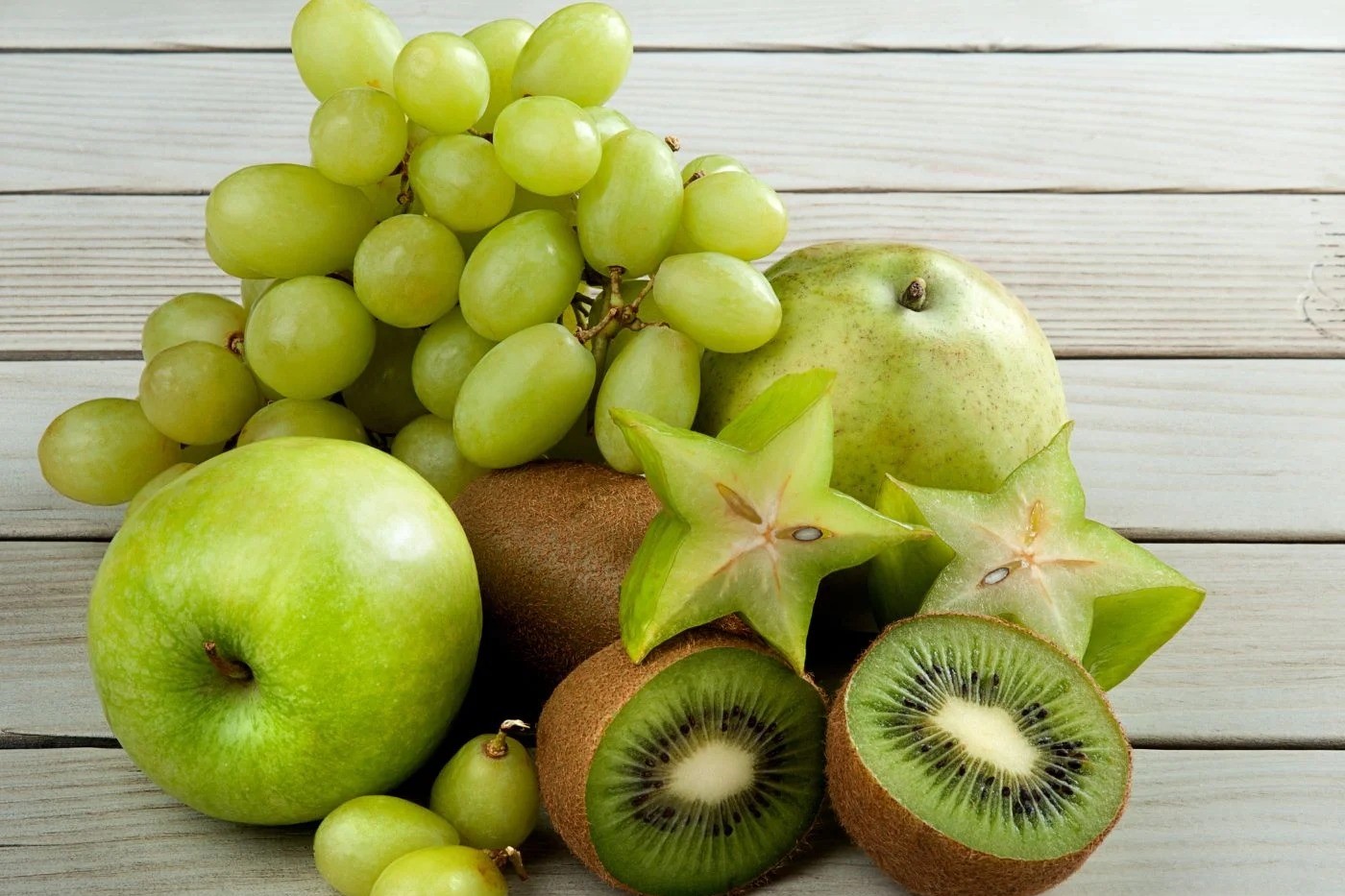Home>Food and Cooking>Top 10 Delicious Green Fruits You Need To Try


Food and Cooking
Top 10 Delicious Green Fruits You Need To Try
Published: January 14, 2024
Explore the top 10 delicious green fruits you need to try, and elevate your culinary experience with these fresh and nutritious options. Discover new recipes and cooking tips for a delightful food adventure.
(Many of the links in this article redirect to a specific reviewed product. Your purchase of these products through affiliate links helps to generate commission for Noodls.com, at no extra cost. Learn more)
Table of Contents
Introduction
When it comes to fruits, the vibrant colors and enticing flavors of green fruits often stand out. From the creamy texture of avocados to the zesty burst of lime, green fruits offer a delightful spectrum of tastes and textures. Whether you're a fruit enthusiast or simply looking to add more variety to your diet, exploring the world of green fruits is a delectable journey waiting to be savored.
Green fruits are not only visually appealing but also pack a powerful nutritional punch. They are rich in essential vitamins, minerals, and antioxidants, making them an excellent choice for maintaining a healthy lifestyle. Additionally, their distinct flavors and versatile uses in both sweet and savory dishes make them a valuable addition to any culinary repertoire.
In this article, we will delve into the top 10 delicious green fruits that you absolutely need to try. From the familiar favorites like green apples and kiwis to the lesser-known gems like green plums and papayas, each fruit offers a unique sensory experience that is sure to tantalize your taste buds. So, prepare to embark on a flavorful exploration of these green wonders, and discover the myriad ways they can elevate your culinary adventures and contribute to your overall well-being.
Avocado
The avocado, also known as the "alligator pear" due to its distinctive shape and rough, textured skin, is a versatile and nutrient-dense fruit that has gained immense popularity in recent years. Native to South Central Mexico, avocados are revered for their rich, creamy texture and mild, buttery flavor. While commonly mistaken for a vegetable, avocados are, in fact, a fruit belonging to the Lauraceae family.
One of the most remarkable features of avocados is their exceptional nutrient profile. They are a great source of healthy monounsaturated fats, which are beneficial for heart health. Additionally, avocados are packed with fiber, potassium, vitamin K, vitamin E, and various B vitamins. These nutrients play a crucial role in supporting overall health, aiding digestion, and promoting radiant skin.
In culinary applications, avocados are incredibly versatile. They are often enjoyed in savory dishes such as guacamole, salads, and sandwiches, where their creamy texture adds a luscious element. Furthermore, avocados can be blended into smoothies and used as a substitute for butter or oil in baking, offering a healthier alternative without compromising on taste.
Beyond their culinary appeal, avocados have also made a significant impact in the realm of wellness and beauty. The natural oils present in avocados are widely utilized in skincare products for their moisturizing and nourishing properties. Additionally, the fruit's high antioxidant content contributes to its anti-inflammatory and anti-aging benefits, making it a sought-after ingredient in various beauty treatments.
Whether enjoyed as a savory spread, a creamy dressing, or a standalone snack, avocados continue to captivate taste buds and inspire culinary creativity. With their impressive nutritional benefits and culinary adaptability, it's no wonder that avocados have secured a permanent place in the hearts and kitchens of food enthusiasts around the world.
Kiwi
The kiwi, also known as the Chinese gooseberry, is a small, fuzzy fruit with a unique combination of sweet and tangy flavors. Originating from China and later cultivated in New Zealand, the kiwi has garnered widespread popularity for its vibrant green flesh speckled with tiny, edible black seeds. This exotic fruit is not only a treat for the taste buds but also a nutritional powerhouse, making it a valuable addition to a balanced diet.
When it comes to nutritional benefits, kiwis are renowned for their high vitamin C content, containing even more of this essential nutrient than oranges. Vitamin C plays a crucial role in supporting the immune system, promoting collagen synthesis for healthy skin, and aiding in the absorption of iron. Additionally, kiwis are a good source of dietary fiber, which supports digestive health and helps maintain a feeling of fullness.
The versatility of kiwis extends beyond their delightful flavor and nutritional value. They can be enjoyed in a myriad of culinary applications, adding a refreshing twist to both sweet and savory dishes. Their vibrant green color and distinct taste make them an eye-catching addition to fruit salads, smoothies, and desserts. Kiwis can also be used to tenderize meat in marinades or as a flavorful topping for yogurt and oatmeal.
In addition to their culinary uses, kiwis have also found their way into the realm of skincare and beauty. The high antioxidant content in kiwis contributes to their anti-aging and skin-rejuvenating properties, making them a popular ingredient in natural skincare products. The enzymes present in kiwis are known for their exfoliating and brightening effects, offering a natural solution for achieving a radiant complexion.
Whether enjoyed on their own or incorporated into various dishes, kiwis continue to captivate the senses with their vibrant color, refreshing taste, and impressive nutritional benefits. From boosting immunity to enhancing the visual appeal of culinary creations, the kiwi stands as a testament to the delightful synergy of flavor, nutrition, and versatility that green fruits have to offer.
Green Apple
Green apples, with their crisp texture and tangy-sweet flavor, have secured a special place in the world of fruits. Belonging to the Malus domestica species, green apples, also known as Granny Smith apples, are celebrated for their vibrant green skin and firm flesh. Originating from Australia in the mid-19th century, these apples have since become a beloved fruit enjoyed in various culinary applications worldwide.
One of the defining characteristics of green apples is their delightful balance of tartness and sweetness. This distinctive flavor profile makes them a versatile ingredient in both sweet and savory dishes. Whether eaten fresh as a refreshing snack or incorporated into pies, salads, and sauces, green apples offer a delightful burst of flavor that adds a dynamic element to culinary creations.
In terms of nutritional benefits, green apples are a rich source of dietary fiber, particularly pectin, which supports digestive health and helps regulate blood sugar levels. Additionally, they are packed with vitamin C, an essential antioxidant that plays a vital role in supporting the immune system and promoting overall well-being. The combination of fiber and antioxidants in green apples makes them a valuable addition to a balanced diet, contributing to improved digestion and enhanced immunity.
Beyond their culinary and nutritional appeal, green apples have also found their way into the realm of natural home remedies and beauty treatments. The natural acids present in green apples are often utilized in DIY skincare solutions for their exfoliating and brightening properties. Whether used in homemade facial masks or natural hair treatments, green apples offer a natural and effective way to enhance skin and hair health.
The versatility of green apples extends beyond traditional culinary uses. Their crisp texture and tangy flavor make them an ideal addition to salads, where they provide a refreshing contrast to other ingredients. Furthermore, green apples can be transformed into delicious homemade applesauce, adding a touch of natural sweetness to a variety of dishes.
Whether enjoyed fresh, baked into pies, or incorporated into creative culinary creations, green apples continue to captivate taste buds with their invigorating flavor and versatile uses. From enhancing the nutritional value of meals to inspiring innovative recipes, green apples stand as a testament to the delightful fusion of flavor, nutrition, and culinary adaptability that green fruits bring to the table.
Honeydew Melon
The honeydew melon, with its succulent flesh and subtly sweet flavor, is a refreshing green fruit that epitomizes the essence of summer. Belonging to the Cucumis melo species, this melon variety is characterized by its pale green, smooth skin and tender, juicy interior. Originating from ancient Persia, honeydew melons have become a beloved fruit cherished for their hydrating properties and delightful taste.
One of the most alluring qualities of honeydew melons is their high water content, which makes them an excellent choice for staying hydrated during the sweltering heat. The juicy flesh of honeydew melons not only quenches thirst but also provides essential electrolytes, making them a perfect snack for replenishing the body's hydration levels. Additionally, the natural sweetness of honeydew melons adds a refreshing touch to summer salads, fruit platters, and smoothies, enhancing the overall sensory experience.
In terms of nutritional benefits, honeydew melons offer a wealth of essential vitamins and minerals. They are a rich source of vitamin C, an antioxidant that supports immune function and promotes collagen synthesis for healthy skin. Furthermore, honeydew melons contain significant levels of vitamin K, which plays a crucial role in bone health and blood clotting. Their potassium content contributes to maintaining healthy blood pressure levels and supporting proper muscle function.
The versatility of honeydew melons extends beyond their refreshing taste and nutritional value. They can be creatively incorporated into a wide range of culinary delights, from chilled soups and sorbets to fruit kebabs and cocktails. The subtle sweetness and delicate aroma of honeydew melons make them a delightful addition to both sweet and savory dishes, adding a touch of sophistication to culinary creations.
In addition to their culinary uses, honeydew melons are often utilized in skincare and beauty regimens. The hydrating properties of honeydew melons make them a popular ingredient in natural face masks and moisturizers, offering a soothing and revitalizing effect on the skin. The high water content and vitamins present in honeydew melons contribute to maintaining skin hydration and promoting a radiant complexion.
Whether enjoyed as a standalone treat, blended into refreshing beverages, or incorporated into creative culinary endeavors, honeydew melons continue to captivate with their hydrating properties, delicate sweetness, and versatile applications. From enhancing hydration to elevating the sensory experience of dishes, honeydew melons stand as a testament to the invigorating fusion of flavor, nutrition, and culinary adaptability that green fruits bring to the table.
Green Grapes
Green grapes, also known as white grapes, are a lusciously sweet and crisp fruit that has captivated palates for centuries. Belonging to the Vitaceae family, green grapes are renowned for their translucent green skin and juicy, succulent flesh. Originating from the Mediterranean region, these versatile fruits have become a staple in culinary applications, ranging from fresh snacking to winemaking.
One of the most alluring qualities of green grapes is their delightful sweetness and refreshing juiciness. Their crisp texture and burst of natural sweetness make them a popular choice for snacking, adding a refreshing element to fruit platters and salads. Whether enjoyed fresh or frozen, green grapes offer a delightful burst of flavor that appeals to both adults and children, making them a versatile and convenient snack option.
In addition to their irresistible taste, green grapes boast an impressive nutritional profile. They are rich in antioxidants, particularly resveratrol, which has been linked to various health benefits, including supporting heart health and reducing inflammation. Furthermore, green grapes are a good source of vitamin C, vitamin K, and potassium, all of which play essential roles in supporting overall well-being and vitality.
The versatility of green grapes extends beyond snacking; they are a valuable ingredient in both sweet and savory culinary creations. From being a classic addition to fruit salads and desserts to adding a touch of sweetness to savory dishes such as chicken or tuna salad, green grapes offer a delightful contrast of flavors and textures. Their natural sweetness also makes them an ideal candidate for homemade jams, jellies, and preserves, adding a burst of fruity goodness to breakfast spreads and baked goods.
In the realm of beverages, green grapes take center stage as a key ingredient in winemaking. Their natural sugars and complex flavors contribute to the production of a wide variety of white wines, sparkling wines, and grape juices. The versatility of green grapes in winemaking highlights their significance in the culinary world and their ability to elevate the sensory experience of beverages.
Whether enjoyed as a refreshing snack, incorporated into culinary creations, or transformed into delightful beverages, green grapes continue to captivate with their sweet juiciness and versatile applications. From enhancing the nutritional value of meals to inspiring innovative recipes, green grapes stand as a testament to the delightful fusion of flavor, nutrition, and culinary adaptability that green fruits bring to the table.
Lime
Limes, with their vibrant green hue and zesty, tangy flavor, are a quintessential ingredient in cuisines around the world. Belonging to the citrus family, limes are revered for their versatility, adding a burst of refreshing acidity to both savory and sweet dishes. Originating from Southeast Asia, limes have made an indelible mark on global culinary traditions, offering a delightful fusion of flavor, aroma, and nutritional benefits.
One of the most defining characteristics of limes is their invigorating citrusy aroma and tangy taste. The juice and zest of limes are prized for their ability to brighten and elevate the flavors of various dishes, ranging from savory salsas and marinades to tangy desserts and refreshing beverages. The acidic nature of limes makes them an ideal candidate for balancing rich or fatty foods, adding a refreshing and palate-cleansing element to culinary creations.
In terms of nutritional benefits, limes are a rich source of vitamin C, an essential antioxidant that supports immune function and promotes overall well-being. The citric acid present in limes aids in digestion and contributes to the body's natural detoxification processes. Additionally, limes contain flavonoids, which have been linked to anti-inflammatory and antibacterial properties, further enhancing their appeal as a valuable dietary addition.
The versatility of limes extends beyond their culinary uses; they are a popular ingredient in natural home remedies and beauty treatments. The astringent properties of lime juice make it a popular choice for skincare, offering a natural solution for clarifying and toning the skin. Furthermore, the refreshing aroma of limes is often utilized in aromatherapy and relaxation techniques, contributing to a sense of rejuvenation and vitality.
Limes also play a pivotal role in the realm of mixology, where their juice is used to craft a wide array of cocktails and mocktails. From the classic margarita to the refreshing mojito, limes add a burst of citrusy brightness that enhances the overall drinking experience. The aromatic oils present in lime zest are also utilized to garnish cocktails, adding a vibrant pop of color and a citrusy aroma.
Whether used to add a zesty kick to savory dishes, create refreshing beverages, or infuse skincare regimens with natural vitality, limes continue to captivate with their invigorating flavor and versatile applications. From enhancing the sensory experience of meals to promoting overall well-being, limes stand as a testament to the delightful fusion of flavor, nutrition, and culinary adaptability that green fruits bring to the table.
Green Pear
The green pear, also known as the Bartlett pear, is a succulent and sweet fruit that has captivated fruit enthusiasts for generations. With its distinctive bell shape and smooth, pale green skin, the green pear offers a delightful sensory experience that combines a luscious texture with a subtle sweetness. Originating from Europe and later introduced to the United States, the green pear has become a beloved fruit cherished for its versatility in culinary applications and its impressive nutritional benefits.
One of the most alluring qualities of green pears is their juicy and tender flesh, which offers a delicate sweetness with a hint of citrus undertones. The smooth texture and aromatic flavor of green pears make them an ideal choice for both snacking and culinary endeavors. Whether enjoyed fresh as a standalone treat or incorporated into a wide range of dishes, green pears add a refreshing and sophisticated touch to culinary creations.
In terms of nutritional benefits, green pears offer a wealth of essential vitamins, minerals, and dietary fiber. They are a rich source of dietary fiber, particularly pectin, which supports digestive health and helps maintain a feeling of fullness, making them an excellent choice for those seeking a healthy and satisfying snack. Additionally, green pears are packed with vitamin C, an essential antioxidant that supports immune function and promotes overall well-being, contributing to their value as a nutritious addition to a balanced diet.
The versatility of green pears extends beyond their delightful flavor and nutritional value. They can be creatively incorporated into a myriad of culinary delights, from classic fruit salads and tarts to savory dishes such as salads and cheese pairings. The natural sweetness and subtle acidity of green pears make them an ideal complement to a wide range of flavors, adding a touch of elegance and sophistication to culinary creations.
Whether enjoyed fresh, poached in aromatic syrups, or incorporated into creative culinary endeavors, green pears continue to captivate with their succulent sweetness and versatile applications. From enhancing the nutritional value of meals to inspiring innovative recipes, green pears stand as a testament to the delightful fusion of flavor, nutrition, and culinary adaptability that green fruits bring to the table.
Green Plums
Green plums, also known as greengage plums, are a unique and delectable fruit that holds a special place in the world of culinary delights. With their vibrant green skin and tender, juicy flesh, green plums offer a delightful sensory experience that combines a subtle tartness with a delicate sweetness. Originating from Western Asia and later introduced to Europe, green plums have become a cherished fruit valued for their exceptional flavor and culinary versatility.
One of the most alluring qualities of green plums is their distinctive flavor profile, which sets them apart from other plum varieties. The flesh of green plums is renowned for its succulent texture and complex balance of sweet and tart notes, making them a sought-after ingredient in both sweet and savory dishes. Whether enjoyed fresh as a refreshing snack or incorporated into a wide range of culinary creations, green plums add a unique and sophisticated touch to the culinary landscape.
In terms of nutritional benefits, green plums offer a wealth of essential vitamins, minerals, and antioxidants. They are a rich source of vitamin C, an essential nutrient that supports immune function and promotes overall well-being. Additionally, green plums contain significant levels of dietary fiber, which supports digestive health and helps maintain a feeling of fullness, making them an excellent choice for those seeking a nutritious and satisfying snack. The natural antioxidants present in green plums contribute to their anti-inflammatory properties, further enhancing their appeal as a valuable dietary addition.
The versatility of green plums extends beyond their delightful flavor and nutritional value. They can be creatively incorporated into a myriad of culinary delights, from classic fruit preserves and compotes to savory dishes such as chutneys and sauces. The unique balance of sweet and tart flavors in green plums makes them an ideal complement to a wide range of ingredients, adding a touch of complexity and sophistication to culinary creations.
Whether enjoyed fresh, pickled in brine, or transformed into delightful preserves, green plums continue to captivate with their succulent texture and versatile applications. From enhancing the nutritional value of meals to inspiring innovative recipes, green plums stand as a testament to the delightful fusion of flavor, nutrition, and culinary adaptability that green fruits bring to the table.
Green Figs
Green figs, with their tender skin and lusciously sweet flesh, are a captivating fruit that has a rich history dating back to ancient times. Belonging to the Moraceae family, green figs are revered for their unique teardrop shape, vibrant green color, and delightful honey-like flavor. Originating from the Mediterranean region and later cultivated in various parts of the world, green figs have become a cherished fruit valued for their exceptional taste, versatile culinary uses, and impressive nutritional benefits.
One of the most alluring qualities of green figs is their succulent and honeyed sweetness, which sets them apart from other fruits. The tender flesh of green figs offers a delightful sensory experience, combining a subtle crunch with a luscious, syrupy texture. Whether enjoyed fresh as a standalone treat or incorporated into a wide range of culinary creations, green figs add a unique and sophisticated touch to the culinary landscape.
In terms of nutritional benefits, green figs offer a wealth of essential vitamins, minerals, and dietary fiber. They are a rich source of dietary fiber, which supports digestive health and helps maintain a feeling of fullness, making them an excellent choice for those seeking a nutritious and satisfying snack. Additionally, green figs contain significant levels of potassium, a vital mineral that supports heart health and helps regulate blood pressure. The natural antioxidants present in green figs contribute to their anti-inflammatory properties, further enhancing their appeal as a valuable dietary addition.
The versatility of green figs extends beyond their delightful flavor and nutritional value. They can be creatively incorporated into a myriad of culinary delights, from classic fig jams and preserves to savory dishes such as salads, pizzas, and cheese pairings. The unique honey-like sweetness and delicate texture of green figs make them an ideal complement to a wide range of flavors, adding a touch of elegance and sophistication to culinary creations.
Whether enjoyed fresh, paired with artisanal cheeses, or transformed into delightful preserves, green figs continue to captivate with their succulent sweetness and versatile applications. From enhancing the nutritional value of meals to inspiring innovative recipes, green figs stand as a testament to the delightful fusion of flavor, nutrition, and culinary adaptability that green fruits bring to the table.
Green Papaya
Green papaya, also known as unripe or young papaya, is a versatile and underappreciated fruit that offers a myriad of culinary possibilities. While ripe papayas are celebrated for their sweet, tropical flavor, green papayas present a unique sensory experience with their firm texture and subtle, tangy taste. Originating from Central America and later cultivated in various tropical regions, green papayas have become a valuable ingredient in a wide range of savory and refreshing dishes, offering a delightful fusion of flavor, texture, and nutritional benefits.
One of the most remarkable qualities of green papayas is their firm, pale green flesh, which provides a refreshing crunch and a subtle tanginess. Unlike their ripe counterparts, green papayas offer a mild and slightly peppery flavor, making them a versatile ingredient in both savory salads and spicy culinary creations. Their firm texture allows them to be shredded, sliced, or cubed, adding a delightful crunch and a refreshing element to a variety of dishes.
In terms of nutritional benefits, green papayas are a rich source of essential nutrients, including vitamin C, vitamin A, and dietary fiber. The high vitamin C content in green papayas supports immune function and promotes overall well-being, while the presence of vitamin A contributes to maintaining healthy vision and skin. Additionally, the dietary fiber in green papayas supports digestive health and helps maintain a feeling of fullness, making them an excellent choice for those seeking a nutritious and satisfying addition to their diet.
The versatility of green papayas extends beyond their delightful flavor and nutritional value. They are a valuable ingredient in the preparation of classic dishes such as Som Tum, a popular Thai green papaya salad, where their crunchy texture and mild flavor complement the spicy, tangy dressing. Green papayas can also be pickled, stir-fried, or used in soups and stews, adding a refreshing and slightly tart element to culinary creations.
Furthermore, green papayas are often utilized in natural home remedies and traditional medicine. The enzymes present in green papayas, particularly papain, are known for their digestive properties and are used in various digestive supplements and remedies. Additionally, green papayas are valued for their anti-inflammatory and antioxidant properties, contributing to their role in promoting overall wellness and vitality.
Whether enjoyed in savory salads, pickled in tangy dressings, or incorporated into traditional remedies, green papayas continue to captivate with their refreshing crunch and versatile applications. From enhancing the nutritional value of meals to inspiring innovative recipes, green papayas stand as a testament to the delightful fusion of flavor, nutrition, and culinary adaptability that green fruits bring to the table.
Conclusion
In conclusion, the world of green fruits is a vibrant tapestry of flavors, textures, and nutritional benefits that continues to captivate both culinary enthusiasts and health-conscious individuals. From the creamy richness of avocados to the zesty burst of limes, each green fruit offers a unique sensory experience that adds depth and versatility to a wide range of culinary creations. As we've explored the top 10 delicious green fruits, it's evident that their impact extends far beyond their delightful taste, encompassing a wealth of nutritional benefits, culinary adaptability, and even contributions to beauty and wellness.
Green fruits have proven to be a powerhouse of essential nutrients, including vitamins, minerals, antioxidants, and dietary fiber, making them valuable additions to a balanced diet. Whether it's the immune-boosting vitamin C in kiwis and limes, the heart-healthy monounsaturated fats in avocados, or the digestive-supporting fiber in green apples and pears, each green fruit offers a unique array of nutrients that contribute to overall well-being.
Furthermore, the culinary adaptability of green fruits knows no bounds. From being enjoyed fresh as a standalone snack to being creatively incorporated into a myriad of dishes, green fruits offer a delightful fusion of flavors and textures that elevate the sensory experience of meals. Whether it's the refreshing crunch of green grapes in a fruit salad, the subtle sweetness of honeydew melons in a sorbet, or the tangy zest of green papayas in a spicy salad, green fruits add a dynamic element to culinary creations, inspiring innovation and creativity in the kitchen.
Beyond their culinary uses, green fruits have also made a significant impact in the realm of beauty and wellness. The natural antioxidants and vitamins present in green fruits have been harnessed for their anti-inflammatory, anti-aging, and skin-rejuvenating properties, contributing to their role in promoting radiant skin and overall wellness.
In essence, the top 10 delicious green fruits offer a delightful fusion of flavor, nutrition, and culinary adaptability that continues to captivate and inspire. Whether enjoyed on their own, incorporated into sweet and savory dishes, or utilized for their natural vitality in beauty and wellness regimens, green fruits stand as a testament to the remarkable synergy of taste, health, and creativity that they bring to the table. As we continue to explore and savor the world of green fruits, it's clear that their impact transcends the boundaries of culinary delight, offering a holistic experience that nourishes the body, tantalizes the taste buds, and inspires a sense of culinary adventure.













